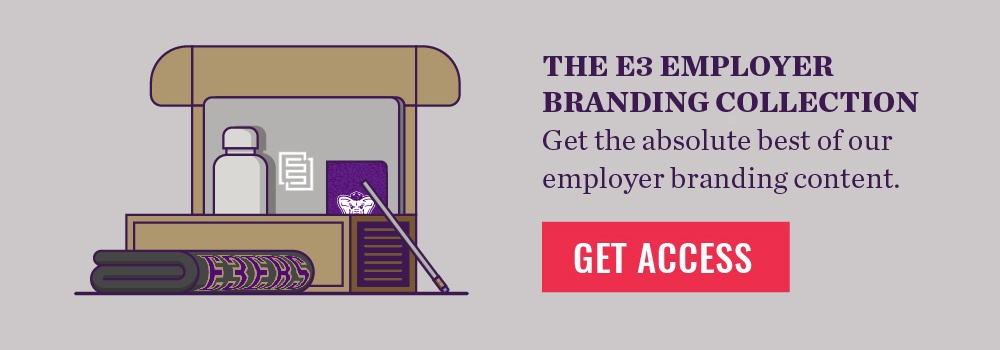I have the pleasure of meeting with a lot of great companies. One company that I met with recently took me on a tour of their newly renovated office. It hit on all the latest trends of the modern workplace: lots of open space, standing desks, a foosball table (my favorite), and free root beer on tap in the breakroom (a close second). The tour made it clear—they wanted to attract the best talent.
But when I asked their leadership team what they felt differentiated them from their competitors, they didn’t mention the foosball table or the snacks in the break room. They lowered their voices and talked about how they have been thoughtful in each step of their people strategy. That they have created their own recipe to blend together the significant areas of their employee lifecycle—with attracting, welcoming, and engaging talent as the key areas.
They acknowledged that their competitors have similar spaces and perks. But they have focused the most time on continuing to build an employee lifecycle that is truly different from other employers, and that no other competitor can duplicate.
How can we create our own recipe towards differentiation? Start with the following ingredients.
Begin with a documented “Why”
In today’s job market, employees have the upper hand when choosing where they work. You’ve created values and have a great careers page on your website. But how do you talk about why people should work with you? What is the “give and get” agreement between you and your people? To create this, you need to identify and document your target candidates and whether all your benefits (tangible or intangible) align with their interests. If they don’t, you’ll need to either reassess your benefits or change your candidate targets to match who you really are as a business.
Ensure the recruiting process is managed by people who know how to attract talent.
You started the company, or your department, but now you’ve had to remove yourself from the recruiting process. When this happens, the level of talent brought into the organization can dramatically dip if you’re not careful. Remember to prioritize the development of how managers search for and select talent as a top criteria for success in their management role.
Onboard your people by focusing on them—not yourself.
Lunch on the first day? Check. Office or desk is set up? Check. Happy hour scheduled? Check. Chance for them to show value within their first week? Not so much. Without a strong onboarding process in place, employees don’t feel welcomed into the organization. However, if the new hire can’t showcase their talent early, they can feel alienated or may hold back what they’re capable of. Create opportunities through projects or reverse Lunch and Learns to allow employees to get to work and show others what they’re all about.
Communicate more than you need to.
You think you’re communicating enough, but I’m sorry, you’re not. But communication in the workplace doesn’t have to be difficult if we think about the different ways your people communicate throughout the day. In person. Email. Text. By understanding these platforms, organizations can better utilize different options for each situation rather than creating a one-size-fits-all approach.
Ask for more feedback than you would want to hear.
It can hurt to receive constructive feedback from your employees, but to move the needle on engagement, organizations need to get comfortable creating a two-way conversation in the workplace. The challenge not only comes from our own resistance, but the resistance for employees to share. Move past this resistance by actively asking for feedback regularly and by providing various options for employees to share their thoughts through surveys or 1:1 opportunities with their managers or leadership.
Take action on the feedback you receive.
Receiving feedback can feel a little like purchasing IKEA furniture. You wanted it. It was hard work finding what you wanted. And now that you have it, what do we do with it? How do we put this together? However, by communicating the feedback you’ve received and the actions you’ll take (however small), you’ll set a good example to your employees that feedback will be listened to and welcomed.
Create clarity in how your people will grow.
Many companies say their goal is to retain employees. But to retain means to keep something in place. Your top people don’t want to be fixed in place, they want to be challenged to use their best strengths to help the organization. And to see how they can do that next year. And the year after.
Rather than simply retaining employees, help them become more than they are today. Help them develop new skills and aptitudes that could allow them to add to their current role in your organization, or even change roles and do something entirely new for you. Don’t just hold onto them.
Ensure managers do not own the performance process.
Employees should own their development, not the manager. So why do things like 1:1’s and performance reviews start with the manager? Flip the table and hand this responsibility over to the employees. Allow them to create the agenda for their 1:1, and their goals for this quarter. The manager instead be a guide and resource to create accountability as the employee works to grow.
Pay attention to how you transition your people within, and out of, the organization.
Great organizations care about their employees regardless of their next step, whether it’s in a new internal role, changing departments, or even moving outside of the organization. The average person changes jobs up to fifteen times during his or her career. It’s unlikely everyone you hire will stay forever, and that’s okay. Ensure that your organization has initiatives in place to ensure thoughtful transitions within or outside of the organization.
Create a culture that is comfortable with failure.
Why should companies talk about failure? Not because it’s trendy, but because it can help create confidence in your culture. Which can lead to more positive thinking. Which can lead to new ideas. Which can lead to positive results for your company. In a study conducted by Georgetown University and Tupperware Brands in early 2017, researchers found that companies that let employees know that failing on a task or a project was okay saw increased sales and productivity.
By following this recipe, you’ll be focusing on how you truly differentiate from other employers. And you’ll be more likely to use this new recipe to better attract and inspire the people you want in your organization.







